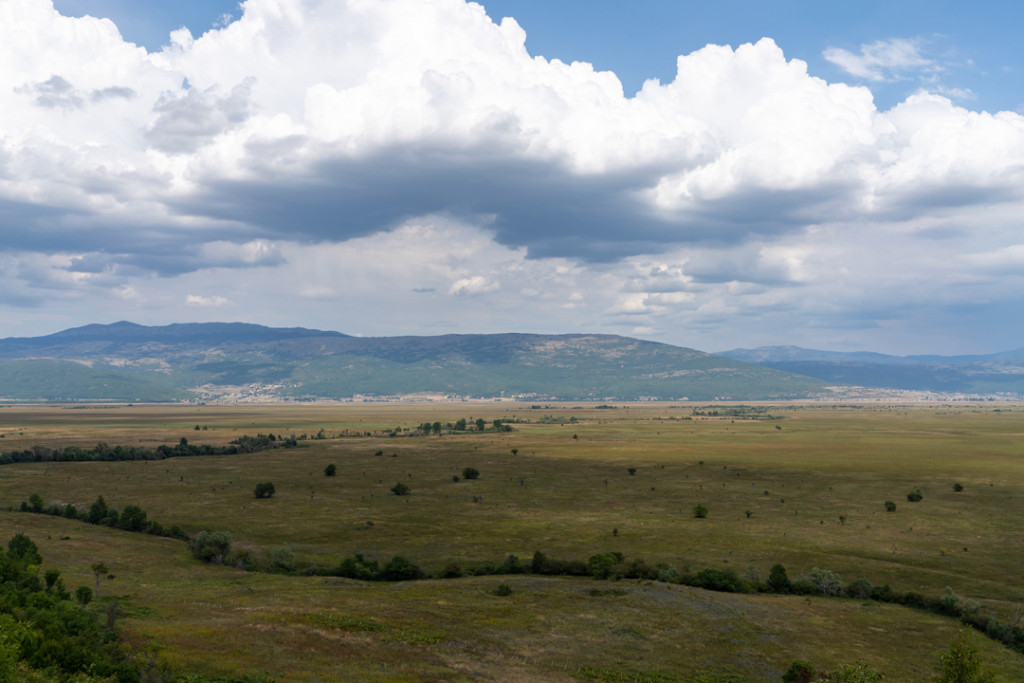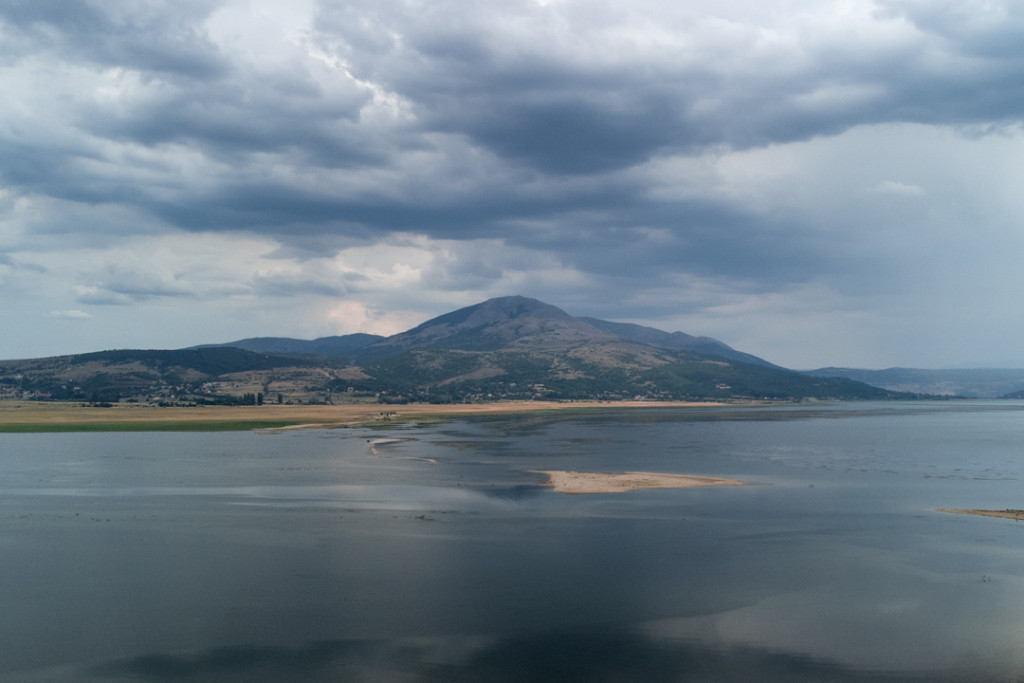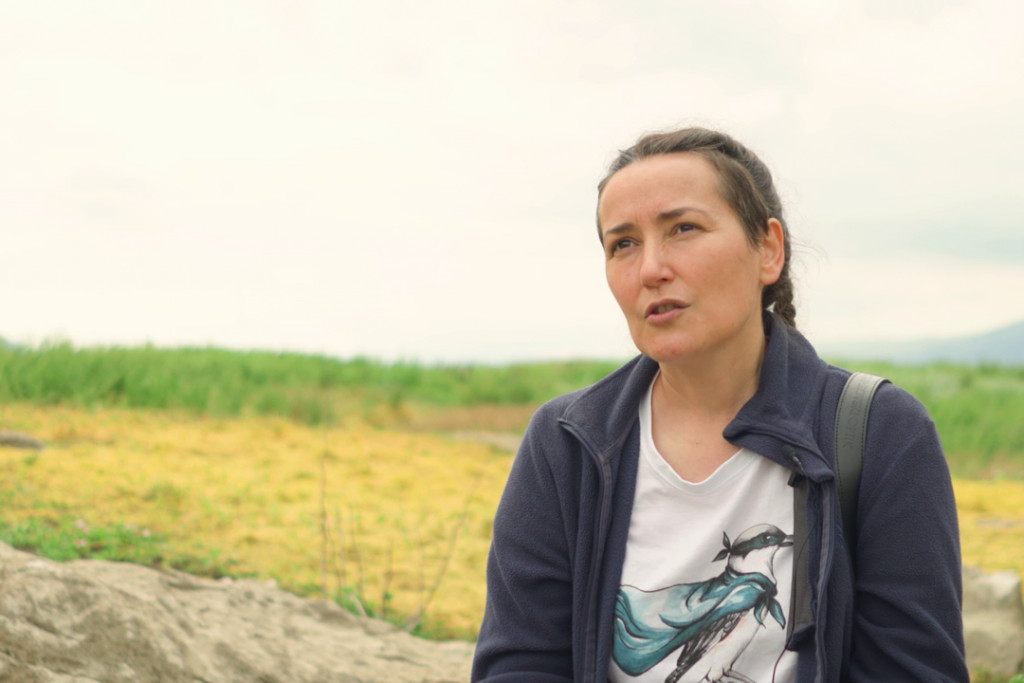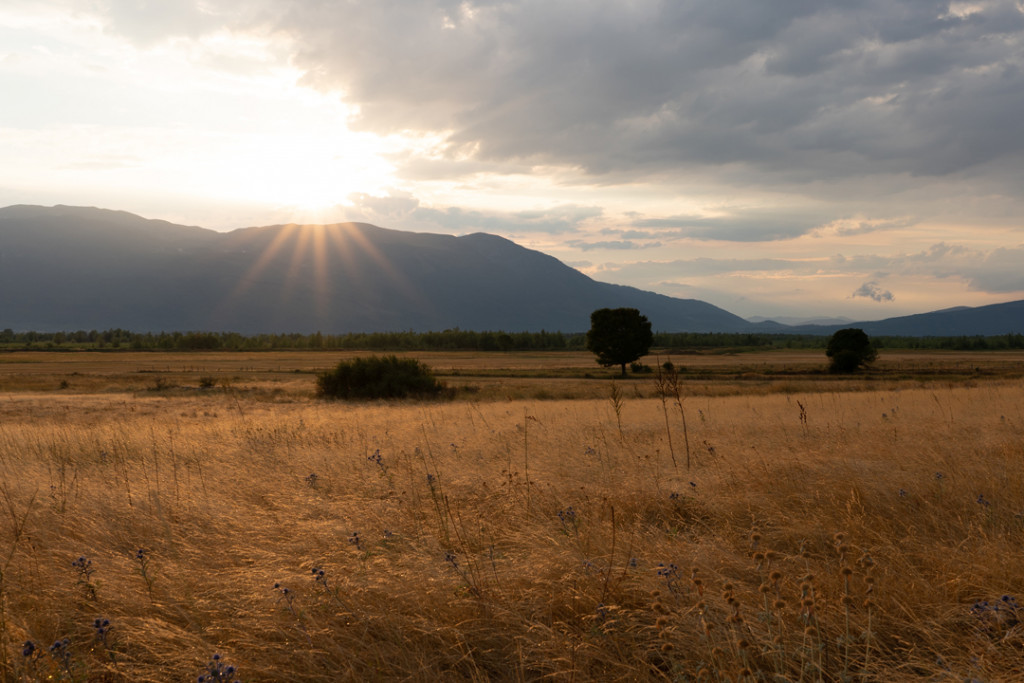
Author: Osman Zukić | Photographer: Almir Kljuno
Livanjsko polje. The Livno Plain. Endless flatlands surrounded by towering mountains. Staretina, Tušnica, Dinara, Šator, Golija, Kamešnica, Grabovica, Cincar – rising above the Plain like ancient deities. Dinara threatens with clouds, leaden and heavy, just like in the old poem.
We drive for several hours on the roads winding around the edges of the Plain and we still fall short of seeing it all. Westbound from Livno to the Buško Lake, then towards Bosansko Grahovo in the north and back to Livno in the south-east. Nearly two hundred kilometres.
We are at the northernmost point of the Plain, under the shadows of clouds. The farthest point to the south is awash in sunshine. The Plain is shimmering in light. A sign warning us of land mines. When the Plain floods, mines float on water, drifting away to a place that may not have a warning sign.
We haven’t seen any livestock, or “treasure”, as locals call it. Cattle and sheep are a treasure. Did Dalmati, an ancient Ilyrian tribe, call their farm animals a treasure? There is evidence that they inhabited these parts; that their sheep and cows grazed here.
They watered their treasure in the rivers of Sturba, Bistrica and Žabljak, the lifeblood of this Plain.
Inhabited since before Christ
There are over forty ruins of ancient settlements in the hills above the Plain. Some archaeological digs suggest that this part of the Earth was inhabited even before Christ – 2000 years B.C. people have lived here ever since.
Now, the number of people living here is decreasing rapidly. As a consequence, there is less livestock, and the Plain gets overgrown, disappearing with each day.
Its uniqueness is vanishing, the distinctness of the plant and animal worlds that took thousands of years to evolve, shaped by the interaction of nature and humans. People here had large herds that grazed in the fields. Later on, they mowed the Plain. Both meant that it turned into grasslands. Forests can be found only sporadically here.
They say that perhaps the only common oak forest in the karst fields in BiH exists here.

The Livno Plain is a typical karst field. It is the biggest flooding karst field in the World and the one most researched in BiH. And yet, it's less explored than the surface of Mars, our guides joke.
The rich biodiversity is illustrated by the fact that there are over 100 species of algae and cyanobacteria, over 30 species of invertebrate zooplanktons, 24 species of dragonflies and 39 species of butterflies. This is why the karst fields of BiH are on the World map of biodiversity hotspots. Just like Madagascar, Philippines, or south-western Australia.
Unique yet endangered areas
Biljana and Goran Topić, the members of the “Naše ptice” (Our Birds) Ornithology Society have been studying the karst fields in BiH for years. Biljana is originally from Bajina Bašta, a small village in Serbia. She grew up watching the programs of the famous British botanist, David Bellamy. She has degree in plant ecology. Goran was the one who brought her to the Livno Plain for the first time. Goran is a biologist, an ornithologist.
The ”Our Birds” Society is also the Bird Ringing Centre for BiH.
“We know exactly where certain species are nesting and where they winter. In order to protect a species, we have to protect it in its entire migration corridor, wherever it turns up. Thanks to ringing, we have key information on the locations of the most important habitats and bird stops, which makes their protection easier”, says Goran.
“Bosnia and Herzegovina is in the Adriatic Flyway, which is one of four migration corridors the birds from north of Europe use to migrate to Africa. One of the corridors and one of the busiest routes goes right over the Livno Plain. Practically every bird flying from the north of Europe flies over the Livno Plain”, explains Goran.
A total of 272 species of birds has been registered here so far, while during the migration period this area is inhabited by around a hundred thousand of various marsh birds.

When they talk about the Livno Plains they also talk about other karst fields in BiH as well – Popovo, Duvno, Glamoč, Kupres – because each such area has its specific characteristics, is equally endangered, and entirely unprotected.
They are characterized by karst that is "like Swiss cheese, all hollow and full of underground tunnels, canals and caves". The plains are dotted with estavelles, orifices in the ground that, depending on whether the underground canals are filled with water or not, act as both springs and sinkholes. The diversity of habitats, river courses, peatlands and wetlands are what makes karst fields such a rare natural phenomenon.
“We know very little about the underground world”, says Biljana, “and what we do know mainly comes from speleologist… Other than that, very little, almost nothing. We found some endemic species of fish, which, in summer, when there is no water on the surface, retreat underground.”
Fires swallow nests and rare plants
There are four travel agencies registered for organizing hunting expeditions in this area. These agencies bring foreign hunters to shoot birds legally. However, our guides warn about the increased use of illegal devices in hunting.
Quails are trapped and killed in large numbers with the help of electronic decoys.
“At night, during migration when quails are in flight, electronic calling devices are used attracting large numbers of birds. The following day hunters can kill dozens and hundreds of birds in just a few hours”, warns Goran.
As a consequence, the number of quails in Europe has reduced by half, primarily in the Balkans, claims Goran.

The Livno Plain is not protected. It’s overrun with bushes and shrubs. Since people still very much remember the efforts their ancestors put into preserving the fields as fields, the local population sets the undergrowth on fire. And that in turn obliterates the diverse world of plants and bird habitats.
“These fires are not monitored, they are not controlled”, says Biljana. “The damage is often irreparable and sometimes it takes dozens of years for the eco-system, the plant community, to recover and to restore to some resemblance of its former self.”
Birds as a bio indicator
Open, grassy habitats are directly dependent on the number of large ruminants.
“Since we don’t have deer in large numbers here, the alternative could be farm animals, says Goran. However, we first decimated the wild ruminants and then the number of domestic ruminants has been reduced, which inevitably brought changes to habitats.“
If it were a protected area, the Livno Plain would have a management and some destructive activities would not be taking place and those that are beneficial both for humans and the nature would develop, hope Biljana and Goran. There is no management program for these valuable habitats and, as they are disappearing, getting overrun with undergrowth or destroyed by fires, thus the numbers and species of birds inhabiting this area are diminishing.
And birds are an extremely important bio indicator. The number of species in a particular area and species populations reflect the state of nature and environment.
Goran explains what the birds are telling us.
"The larger number of species, the healthier the environment and nature. If the population of a species decreases, we know unambiguously that something harmful is happening and if we monitor these species and changes, we can prevent further destruction and deterioration of natural habitats. "
No people, no farm animals
For Biljana, the reason for changes in the Livno Plain is depopulation. People have left to bigger cities or abroad, the industrialization imposed new standards. And wars severed the ties of some people with their ancestral homes forever.
"Livestock farming is really necessary in this area if we wish to maintain the Plain as it is today. We observed during our stay here, conducting our research, that the number of livestock is significantly lower than at the beginning of the twentieth century, significantly lower than in the fifties and sixties or eighties of the last century. "
Here, in the northern part of the Plain, there were a few thousands of people mid-last century. Nearly a thousand households. It is estimated that they had around ten thousand cows and about twenty thousand sheep.

Today, the situation has changed drastically. There are two farms in the northern part with a hundred cows and "apart from that, maybe six or seven cows spread across a few households."
It can take you up to two hours to drive through these villages, but only a few hundred people live there, while the potential for cattle farming seems limitless, just like the Plain itself.
"The only positive thing is that there is still a large number, a relatively large number, of sheep. There are people who have several hundred, even a thousand sheep. And that's good and it's something that maintains this part of the Plain just as it is. The Plain is best preserved in those areas with most sheep. "
The future of the Plain is still good
In addition to continental species of plants and animals, here you can also find the Mediterranean ones thanks to the specific climate. Some mountain species of birds are nesting in high mountain ranges overlooking the Plain.
If you ask Biljana what she feels when she comes to the Livno Plain, she will tell you that she experiences highly mixed emotions. She will say that it is a combination of positive emotions that are stemming from her love of the Plain and the people she meets here and also from the memories that tie her to this area. She will also say that she is sad when she sees anything that is harmful to the nature, when she sees that a beautiful meadow has been ploughed or that something has been burnt, or that rubbish has been dumped at a new location.
When you ask Goran how many bird calls he can recognize, he will tell you that he doesn’t have a particularly good ear or that he is particularly talented for recognising birds’ calls, but he still can recognize around two hundred species only by hearing their song. And each time, he will tell you something about that particular bird. When he hears the black woodpecker, he will say that it is our biggest woodpecker, and that it is the indicator of preserved ancient forests.
They claim that some habitats are already lost forever, that some parts of the Plain have been irretrievably damaged, but that the future of this area is still good. Their colleagues biologists who come to visit from various parts of Europe are fascinated with the number of preserved habitats. They say that something like that, on such a large scale, does not exist anywhere in Europe.
For them, the key factors for preserving karst fields are the legal protection of the plains, and establishing and appointing a good management.
Because “no other country in the world has as a divers and unique system of karst fields as BiH”. It would be only natural to look after our most precious treasures.
Since the karst fields are not protected, they gradually lose their uniqueness and distinctiveness.
We climbed up to vantage points and looked at that grassy land that stretches almost as far as the eye can see. Tall birch trees are swaying in the wind that’s trying to pull them out with the roots. The common oak that can grow up to eight hundred years is waiting for the rain coming from Dinara. We are escaping the rain driving towards south-east. The oak loves the soft, fertile, and moist soil with bountiful underground water courses. Its canopies become dark with the clouds from which it finally rains. In the first dusk, you can barely see the roads.
